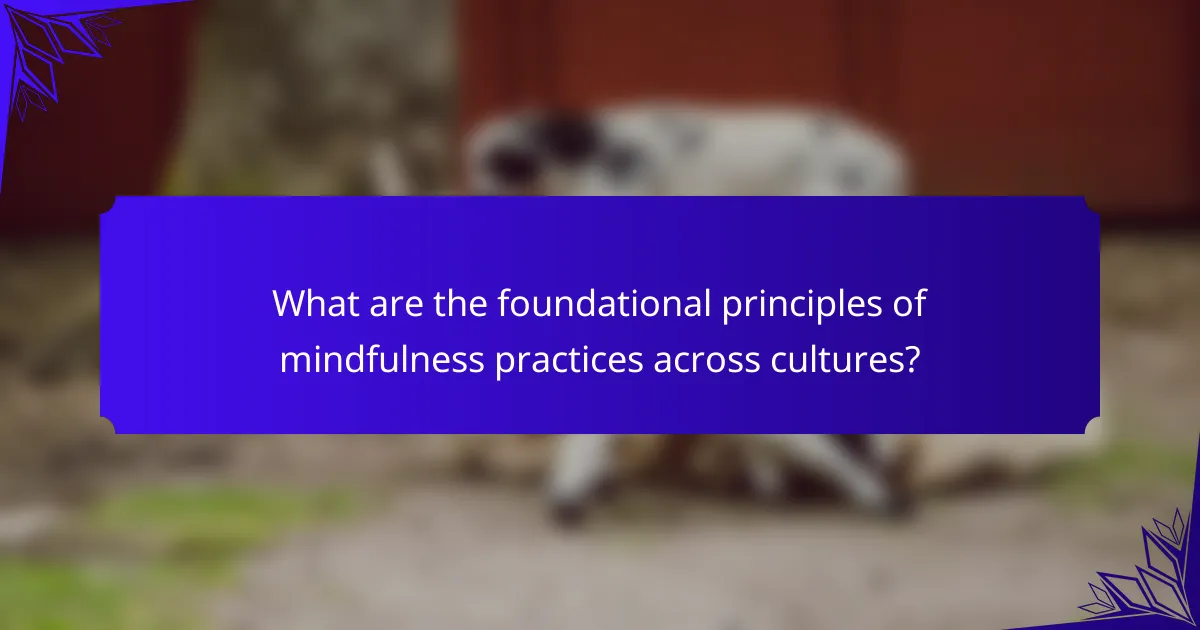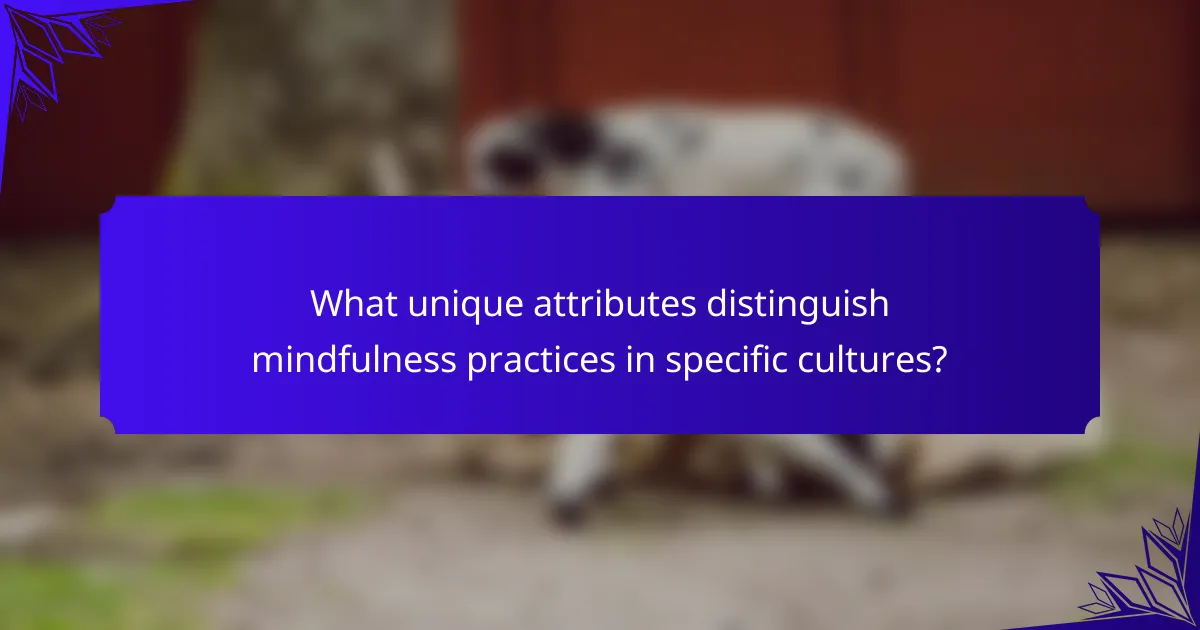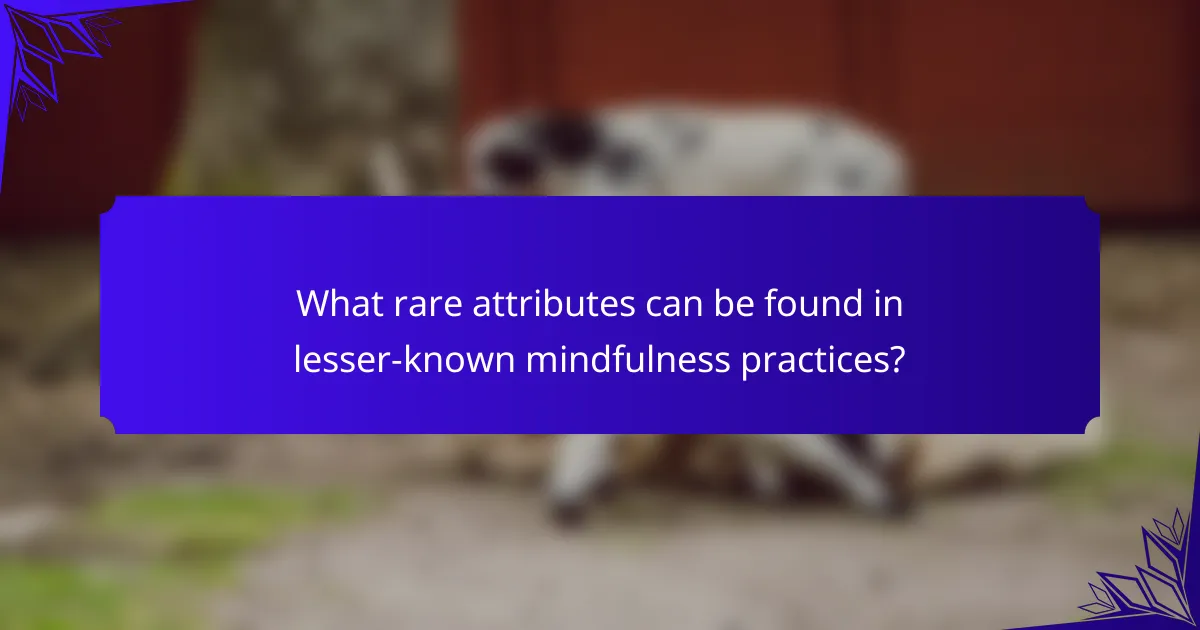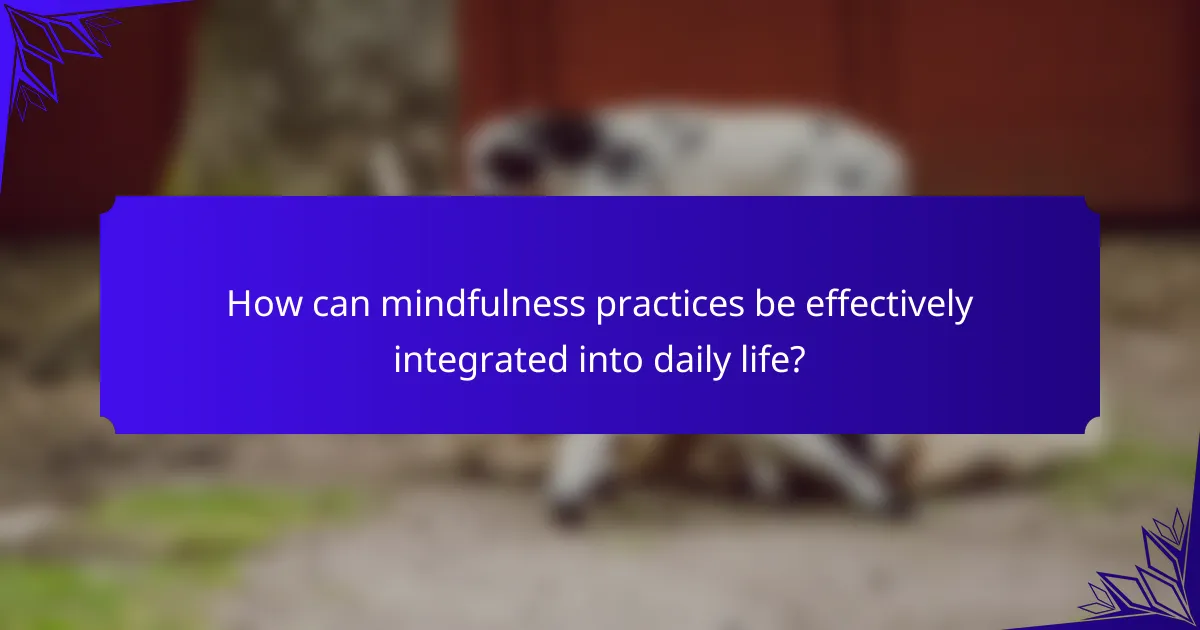Mindfulness practices offer significant benefits like reduced stress and improved emotional regulation. Techniques vary across cultures, including meditation, breathing exercises, and mindful movement. Unique cultural attributes shape these practices, revealing diverse approaches such as Zen Buddhism’s simplicity and Indigenous nature immersion. Integrating mindfulness into daily routines enhances its effectiveness and cultivates a lasting mindful attitude.

What are the foundational principles of mindfulness practices across cultures?
Mindfulness practices across cultures share foundational principles such as awareness, presence, and non-judgment. These core attributes foster a deeper connection to the self and surroundings. Techniques vary, including meditation, breathing exercises, and mindful movement, yet they all emphasize the importance of being present. The benefits of these practices include reduced stress, improved emotional regulation, and enhanced overall well-being, demonstrating their universal appeal. Integration of mindfulness into daily life enhances its effectiveness, allowing individuals to cultivate a mindful attitude beyond formal practices.
How do different cultures interpret mindfulness?
Different cultures interpret mindfulness through unique practices and philosophies. In Buddhism, mindfulness emphasizes awareness and presence, often through meditation. In contrast, Western approaches may focus on stress reduction and mental health, integrating mindfulness into therapeutic settings. Indigenous cultures often incorporate mindfulness in community rituals and nature connection. Each interpretation highlights distinct benefits, such as emotional regulation in Western contexts or spiritual growth in Eastern traditions. The integration of these diverse practices can enrich personal and collective experiences of mindfulness.
What are the common techniques used in various mindfulness practices?
Mindfulness practices utilize various techniques to enhance awareness and presence. Common techniques include meditation, breathing exercises, body scanning, mindful walking, and guided imagery. Each technique promotes relaxation and focus, contributing to overall well-being. For instance, meditation often involves focusing on breath or a mantra, while body scanning encourages awareness of bodily sensations. These practices can be integrated into daily life to foster mindfulness and reduce stress.
What role does meditation play in cultural mindfulness practices?
Meditation is central to cultural mindfulness practices as it fosters awareness and presence. Various cultures employ meditation techniques, such as Zen meditation in Japan and Vipassana in India, to enhance mental clarity and emotional regulation. These practices often share the root attribute of promoting inner peace. Unique to some traditions, such as Tibetan Buddhism, are visualization techniques that deepen spiritual insight. As a result, meditation serves as a bridge for integrating mindfulness into daily life, enhancing overall well-being across diverse cultural contexts.
How is breathwork utilized in different traditions?
Breathwork is utilized in various traditions for enhancing mental clarity and emotional balance. In yoga, breath control (pranayama) fosters mindfulness and relaxation. Tibetan Buddhism emphasizes breath as a tool for meditation, promoting awareness and spiritual growth. Native American practices use breath to connect with nature and facilitate healing. Each tradition highlights unique attributes of breathwork, yet all share the common goal of promoting well-being and self-awareness.
What benefits are universally associated with mindfulness practices?
Mindfulness practices universally enhance mental well-being, reduce stress, and improve focus. These techniques foster emotional regulation and promote a greater sense of self-awareness. Research indicates that regular mindfulness engagement can lead to improved relationships and overall life satisfaction. Additionally, these practices are linked to physiological benefits, such as lower blood pressure and improved immune response.
How does mindfulness contribute to mental well-being?
Mindfulness significantly enhances mental well-being by promoting emotional regulation and reducing stress. It encourages present-moment awareness, leading to improved focus and clarity. Various cultural practices, such as meditation and breathing techniques, provide diverse methods to cultivate mindfulness. These practices contribute to lower anxiety levels, increased resilience, and greater overall life satisfaction. Integrating mindfulness into daily routines can foster a deeper connection to oneself and enhance interpersonal relationships.
What physical health benefits are linked to mindfulness techniques?
Mindfulness techniques offer various physical health benefits, including reduced stress, lower blood pressure, and improved immune function. Regular practice can enhance overall well-being and promote a healthier lifestyle. Research indicates that mindfulness reduces cortisol levels, leading to decreased anxiety and improved heart health. Additionally, mindful breathing exercises can enhance lung capacity and respiratory efficiency, contributing to better physical performance.

What unique attributes distinguish mindfulness practices in specific cultures?
Mindfulness practices are distinguished by unique cultural attributes that reflect their origins. For example, Zen Buddhism emphasizes breath awareness and simplicity, while Tibetan mindfulness incorporates visualization techniques. In contrast, Western mindfulness often focuses on stress reduction and cognitive behavioural therapy integration. Each culture’s historical context shapes its specific practices, revealing rare attributes like communal meditation in African traditions and nature-based mindfulness in Indigenous cultures.
How does Japanese Zen Buddhism shape mindfulness practices?
Japanese Zen Buddhism profoundly influences mindfulness practices by emphasizing present-moment awareness and meditation techniques. Zen teachings encourage practitioners to cultivate a deep connection with their thoughts and surroundings, fostering clarity and focus. The practice of Zazen, or seated meditation, serves as a foundational technique, allowing individuals to observe their thoughts without judgment. This unique attribute of Zen mindfulness promotes emotional regulation and stress reduction. As a result, practitioners often experience enhanced well-being and improved mental health. Integrating these principles can enrich mindfulness practices across various cultures, highlighting the universal benefits of being present.
What influence does Tibetan Buddhism have on mindfulness techniques?
Tibetan Buddhism significantly influences mindfulness techniques through its unique practices and philosophies. It emphasizes awareness and compassion, integrating meditation and rituals that enhance mental clarity and emotional stability. The practice of “Shamatha” develops concentration, while “Vipassana” fosters insight into the nature of reality, enriching modern mindfulness approaches. Tibetan traditions also incorporate visualization and chanting, which serve as tools for deepening mindfulness experiences. These elements create a holistic framework that enhances the effectiveness of mindfulness in various cultural contexts.
How is mindfulness integrated into Indigenous cultures?
Mindfulness is deeply integrated into Indigenous cultures through practices that emphasize connection to nature, community, and spirituality. These practices often include rituals, storytelling, and communal gatherings that foster awareness and presence. For example, many Indigenous groups use meditation techniques rooted in their cultural traditions to promote mental well-being and resilience. Unique attributes of these practices include the incorporation of ancestral knowledge and the emphasis on collective healing. As a result, mindfulness serves not only as a personal tool but also as a means to strengthen community bonds and cultural identity.

What rare attributes can be found in lesser-known mindfulness practices?
Lesser-known mindfulness practices exhibit rare attributes that enhance their uniqueness. These practices often incorporate elements such as nature immersion, which fosters a deep connection with the environment, and sound healing, utilizing specific frequencies to promote relaxation. Another rare attribute is the integration of ancient rituals, which can provide a historical context and deepen the mindfulness experience. Additionally, some practices focus on community engagement, emphasizing collective mindfulness sessions that strengthen social bonds. These attributes contribute to a richer, more diverse mindfulness experience across cultures.
What are some unique mindfulness rituals from around the world?
Mindfulness rituals vary globally, offering unique techniques and benefits. For example, Japanese Zen gardens promote tranquility through raking patterns, fostering focus. In India, Pranayama breathing exercises enhance awareness and relaxation. Tibetan monks practice meditation with mantras, deepening spiritual connection. Brazilian capoeira combines movement and music, encouraging mindfulness through physical expression. Each practice integrates cultural values, enriching the mindfulness experience.
How do specific cultural events enhance mindfulness practices?
Cultural events enhance mindfulness practices by providing immersive experiences that foster awareness and presence. These events often incorporate traditional rituals, music, and communal activities that promote connection and reflection. For example, festivals celebrating nature encourage participants to engage with their surroundings mindfully. Unique attributes of these cultural practices, such as specific meditation techniques or ceremonial mindfulness, can deepen participants’ experiences. As a result, individuals often report increased emotional well-being and a stronger sense of community.

How can mindfulness practices be effectively integrated into daily life?
Mindfulness practices can be effectively integrated into daily life through consistent routines and intentional moments of awareness. Start by setting aside specific times for mindfulness exercises, such as meditation or deep breathing, each day. Incorporate mindfulness into routine activities like eating, walking, or even washing dishes by focusing fully on the experience. Engage in mindful communication by actively listening and being present in conversations. Utilize reminders, like phone alerts, to pause and breathe throughout the day. Lastly, reflect on your experiences in a journal to reinforce the benefits and insights gained from mindfulness.
What are the best practices for adopting mindfulness techniques?
To adopt mindfulness techniques effectively, practice consistency, start with short sessions, and create a dedicated space. Incorporate techniques from various cultures, such as breath awareness from Buddhism or mindful walking from Taoism. As a result, you’ll enhance focus and reduce stress. Emphasize the unique attribute of integrating diverse practices to enrich personal experience.
What common mistakes should be avoided when starting mindfulness practices?
Starting mindfulness practices can be transformative, but common mistakes can hinder progress. Avoiding unrealistic expectations is crucial; many expect immediate results, which can lead to frustration. Neglecting consistency is another pitfall; regular practice is essential for benefits to manifest. Additionally, focusing too much on the outcome rather than the experience itself can detract from the practice. Lastly, disregarding the cultural context of mindfulness techniques may limit understanding and integration. Embracing these insights fosters a more effective mindfulness journey.
How can mindfulness be tailored to fit individual lifestyles?
Mindfulness can be tailored to individual lifestyles by incorporating personal preferences and daily routines. Techniques such as mindful breathing, body scans, and meditation can be adapted to fit varying time constraints and environments.
For instance, someone with a busy schedule may prefer short, focused mindfulness exercises, while others might engage in longer sessions. Cultural practices, such as yoga or tai chi, can also be integrated based on individual interests, enhancing the overall benefits of mindfulness.
Additionally, unique attributes like personal goals and stressors can inform the choice of mindfulness techniques, ensuring they resonate with the individual’s life context. This personalized approach increases engagement and effectiveness, reinforcing mindfulness as a sustainable practice.


